Long-Term (1979–2024) Variation Trend in Wave Power in the South China Sea
Abstract
1. Introduction
2. Data and Methods
2.1. Data
2.1.1. Reanalysis Data
2.1.2. Bouy Observations
2.2. Methods
2.2.1. Calculation of the Energy Density
2.2.2. Determination of the Long-Term Trend
3. Results
3.1. Validity of ERA5 Data Applied in This Study
3.2. Overall Characteristics of Interannual WP Variations
3.3. Seasonal Characteristics of WP Interannual Variations
4. Discussion
4.1. Effects of Seasonal Wind Fields on WP Variation
4.2. Modulation of the Background Swell in Relation to the WP Variation
5. Conclusions
Author Contributions
Funding
Institutional Review Board Statement
Informed Consent Statement
Data Availability Statement
Acknowledgments
Conflicts of Interest
Abbreviations
| WP | Wave power |
| SCS | South China Sea |
| ERA5 | European Centre for Medium-Range Weather Forecasts Reanalysis v5 |
| CFSv2 | NCEP version 2 coupled forecast system model |
| NCEP | National Centers for Environmental Prediction |
| Probability density function | |
| CDF | Cumulative density function |
| MAE | Mean absolute error |
| RMSE | Root means square error |
| SI | Scatter index |
| R | Correlation coefficient |
References
- Iglesias, G.; López, M.; Carballo, R.; Castro, A.; Fraguela, J.A.; Frigaard, P. Wave energy potential in Galicia (NW Spain). Renew. Energy 2009, 34, 2323–2333. [Google Scholar] [CrossRef]
- Lehmann, M.; Karimpour, F.; Goudey, C.A.; Jacobson, P.T.; Alam, M.-R. Ocean wave energy in the United States: Current status and future perspectives. Renew. Sustain. Energy Rev. 2017, 74, 1300–1313. [Google Scholar] [CrossRef]
- Kilcher, L.; García Medina, G.; Yang, Z. A scalable wave resource assessment methodology: Application to U.S. waters. Renew. Energy 2023, 217, 119094. [Google Scholar] [CrossRef]
- Bouhrim, H.; El Marjani, A.; Nechad, R.; Hajjout, I. Ocean wave energy conversion: A review. J. Mar. Sci. Eng. 2024, 12, 1922. [Google Scholar] [CrossRef]
- Pazhouhan, M.; Karimi Mazraeshahi, A.; Jahanbakht, M.; Rezanejad, K.; Rohban, M.H. Wave and tidal energy: A patent landscape study. J. Mar. Sci. Eng. 2024, 12, 1967. [Google Scholar] [CrossRef]
- Li, B.; Chen, W.; Li, J.; Liu, J.; Shi, P. Integrated monitoring and assessments of marine energy for a small uninhabited island. Energy Rep. 2022, 8, 63–72. [Google Scholar] [CrossRef]
- Li, B.; Li, J.; Chen, W.; Liu, J.; Shi, P. Meteo-climatic conditions of wind and wave in the perspective of joint energy exploitation: Case study of Dongluo Island, Hainan. Atmosphere 2022, 13, 1076. [Google Scholar] [CrossRef]
- Zheng, C.W.; Pan, J.; Li, J.X. Assessing the China Sea wind energy and wave energy resources from 1988 to 2009. Ocean Eng. 2013, 65, 39–48. [Google Scholar] [CrossRef]
- Zhou, G.; Huang, J.; Zhang, G. Evaluation of the wave energy conditions along the coastal waters of Beibu Gulf, China. Energy 2015, 85, 449–457. [Google Scholar] [CrossRef]
- Chen, X.; Wang, K.; Zhang, Z.; Zeng, Y.; Zhang, Y.; O’Driscoll, K. An assessment of wind and wave climate as potential sources of renewable energy in the nearshore Shenzhen coastal zone of the South China Sea. Energy 2017, 134, 789–801. [Google Scholar] [CrossRef]
- Wang, Z.; Duan, C.; Dong, S. Long-term wind and wave energy resource assessment in the South China Sea based on 30-year hindcast data. Ocean Eng. 2018, 163, 58–75. [Google Scholar] [CrossRef]
- Sun, Z.; Zhang, H.; Xu, D.; Liu, X.; Ding, J. Assessment of wave power in the South China Sea based on 26-year high-resolution hindcast data. Energy 2020, 197, 117218. [Google Scholar] [CrossRef]
- Sun, Z.; Zhang, H.; Liu, X.; Ding, J.; Cai, Z. Wave energy assessment of the Xisha Group Islands zone for the period 2010–2019. Energy 2021, 220, 119721. [Google Scholar] [CrossRef]
- Chen, W.; Liu, J.; Li, J.; Sun, L.; Li, B.; Xing, H.; Shi, P. Wave energy assessment for the nearshore region of the northern South China Sea based on in situ observations. Energy Rep. 2022, 8, 149–158. [Google Scholar] [CrossRef]
- Li, B.; Chen, W.; Li, J.; Liu, J.; Shi, P.; Xing, H. Wave energy assessment based on reanalysis data calibrated by buoy observations in the southern South China Sea. Energy Rep. 2022, 8, 5067–5079. [Google Scholar] [CrossRef]
- Wen, Y.; Kamranzad, B.; Lin, P. Joint exploitation potential of offshore wind and wave energy along the south and southeast coasts of China. Energy 2022, 249, 123710. [Google Scholar] [CrossRef]
- Ching-Piao, T.; Ching-Her, H.; Chien, H.; Hao-Yuan, C. Study on the wave climate variation to the renewable wave energy assessment. Renew. Energy 2012, 38, 50–61. [Google Scholar] [CrossRef]
- Zheng, C.W.; Li, C.Y. Variation of the wave energy and significant wave height in the China Sea and adjacent waters. Renew. Sustain. Energy Rev. 2015, 43, 381–387. [Google Scholar] [CrossRef]
- Zheng, C.; Zhang, R.; Shi, W.; Li, X.; Chen, X. Trends in significant wave height and surface wind speed in the China Seas between 1988 and 2011. J. Ocean Univ. China 2017, 16, 717–726. [Google Scholar] [CrossRef]
- Zheng, C.-W. Global oceanic wave energy resource dataset—With the Maritime Silk Road as a case study. Renew. Energy 2021, 169, 843–854. [Google Scholar] [CrossRef]
- Sun, P.; Xu, B.; Wang, J. Long-term trend analysis and wave energy assessment based on ERA5 wave reanalysis along the Chinese coastline. Appl. Energy 2022, 324, 119709. [Google Scholar] [CrossRef]
- Sun, P.; Wang, J. Long-term variability analysis of wave energy resources and its impact on wave energy converters along the Chinese coastline. Energy 2024, 288, 129644. [Google Scholar] [CrossRef]
- Liu, J.; Li, R.; Li, S.; Meucci, A.; Young, I.R. Increasing wave power due to global climate change and intensification of Antarctic Oscillation. Appl. Energy 2024, 358, 122572. [Google Scholar] [CrossRef]
- Duan, Y.; Liu, Y.; Li, M.; Zhou, M.; Yang, Y. Survey of reefs based on Landsat 8 operational land imager (OLI) images in the Nansha Islands, South China Sea. Acta Oceanol. Sin. 2016, 35, 11–19. [Google Scholar] [CrossRef]
- Shaw, P.-T. The seasonal variation of the intrusion of the Philippine sea water into the South China Sea. J. Geophys. Res. Oceans 1991, 96, 821–827. [Google Scholar] [CrossRef]
- Zheng, C.W.; Zhuang, H.; Li, X.; Li, X.Q. Wind energy and wave energy resources assessment in the East China Sea and South China Sea. Sci. China Technol. Sci. 2012, 55, 163–173. [Google Scholar] [CrossRef]
- Wang, Z.; Dong, S.; Dong, X.; Zhang, X. Assessment of wind energy and wave energy resources in Weifang sea area. Int. J. Hydrogen Energy 2016, 41, 15805–15811. [Google Scholar] [CrossRef]
- Dong, S.; Gong, Y.J.; Wang, Z.F.; Incecik, A. Wind and wave energy resources assessment around the Yangtze River Delta. Ocean Eng. 2019, 182, 75–89. [Google Scholar] [CrossRef]
- Su, H.; Wei, C.; Jiang, S.; Li, P.; Zhai, F. Revisiting the seasonal wave height variability in the South China Sea with merged satellite altimetry observations. Acta Oceanol. Sin. 2017, 36, 38–50. [Google Scholar] [CrossRef]
- Molina, M.O.; Gutiérrez, C.; Sánchez, E. Comparison of ERA5 surface wind speed climatologies over Europe with observations from the HadISD dataset. Int. J. Climatol. 2021, 41, 4864–4878. [Google Scholar] [CrossRef]
- Hersbach, H.; Bell, B.; Berrisford, P.; Biavati, G.; Horányi, A.; Muñoz Sabater, J.; Nicolas, J.; Peubey, C.; Radu, R.; Rozum, I.; et al. ERA5 hourly data on single levels from 1940 to present. Copernic. Clim. Chang. Serv. (C3S) Clim. Data Store (CDS) 2023. [Google Scholar] [CrossRef]
- Liu, J.; Li, B.; Chen, W.; Li, J.; Yan, J. Evaluation of ERA5 wave parameters with in situ data in the South China Sea. Atmosphere 2022, 13, 935. [Google Scholar] [CrossRef]
- Wang, J.; Li, B.; Gao, Z.; Wang, J. Comparison of ECMWF significant wave height forecasts in the China Sea with buoy data. Weather Forecast. 2019, 34, 1693–1704. [Google Scholar] [CrossRef]
- Li, J.; Tong, Y.; Xu, Y.; Chen, W.; Shi, P. Reconstruction of significant wave height for bottom-mounted acoustic profilers with pressure sensor failure: A case study. Ocean Eng. 2025, 319, 120270. [Google Scholar] [CrossRef]
- Li, B.; Li, J.; Liu, J.; Tang, S.; Chen, W.; Shi, P.; Liu, Y. Calibration experiments of CFOSAT wavelength in the Southern South China Sea by artificial neural networks. Remote Sens. 2022, 14, 773. [Google Scholar] [CrossRef]
- Liu, Y.; Lin, M.; Jiang, X.; Sun, X.; Song, X. A comparison of multiplatform wind products in the South China Sea during summer and autumn in 2019. J. Oceanol. Limnol. 2021, 39, 2181–2194. [Google Scholar] [CrossRef]
- Jiang, Y.; Han, S.; Shi, C.; Gao, T.; Zhen, H.; Liu, X. Evaluation of HRCLDAS and ERA5 Datasets for Near-Surface Wind over Hainan Island and South China Sea. Atmosphere 2021, 12, 766. [Google Scholar] [CrossRef]
- Silva, K.; Abreu, T.; Oliveira, T.C.A. Inter- and intra-annual variability of wave energy in Northern mainland Portugal: Application to the HiWave-5 project. Energy Rep. 2022, 8, 6411–6422. [Google Scholar] [CrossRef]
- Zhang, W.; Zhao, H.; Chen, G.; Yang, J. Assessing the performance of SWAN model for wave simulations in the Bay of Bengal. Ocean Eng. 2023, 285, 115295. [Google Scholar] [CrossRef]
- Schuster, U.; Watson, A.J.; Bates, N.R.; Corbiere, A.; Gonzalez-Davila, M.; Metzl, N.; Pierrot, D.; Santana-Casiano, M. Trends in North Atlantic sea-surface fCO2 from 1990 to 2006. Deep Sea Res. Part II 2009, 56, 620–629. [Google Scholar] [CrossRef]
- Santos, F.; Gómez-Gesteira, M.; de Castro, M.; Álvarez, I. Upwelling along the western coast of the Iberian Peninsula: Dependence of trends on fitting strategy. Clim. Res. 2011, 48, 213–218. [Google Scholar] [CrossRef]
- Kim, K.-Y.; Kim, Y. A comparison of sea level projections based on the observed and reconstructed sea level data around the Korean Peninsula. Clim. Change 2017, 142, 23–36. [Google Scholar] [CrossRef]
- Li, C. Interaction between anomalous winter monsoon in East Asia and El Nino events. Adv. Atmos. Sci. 1990, 7, 36–46. [Google Scholar] [CrossRef]
- Young, I.R.; Zieger, S.; Babanin, A.V. Global trends in wind speed and wave height. Science 2011, 332, 451–455. [Google Scholar] [CrossRef] [PubMed]
- Bromirski, P.D.; Cayan, D.R.; Helly, J.; Wittmann, P. Wave power variability and trends across the North Pacific. J. Geophys. Res. Oceans 2013, 118, 6329–6348. [Google Scholar] [CrossRef]
- Reeve, D.E.; Chen, Y.; Pan, S.; Magar, V.; Simmonds, D.J.; Zacharioudaki, A. An investigation of the impacts of climate change on wave energy generation: The Wave Hub, Cornwall, UK. Renew. Energy 2011, 36, 2404–2413. [Google Scholar] [CrossRef]
- Kamranzad, B.; Etemad-Shahidi, A.; Chegini, V. Assessment of wave energy variation in the Persian Gulf. Ocean Eng. 2013, 70, 72–80. [Google Scholar] [CrossRef]
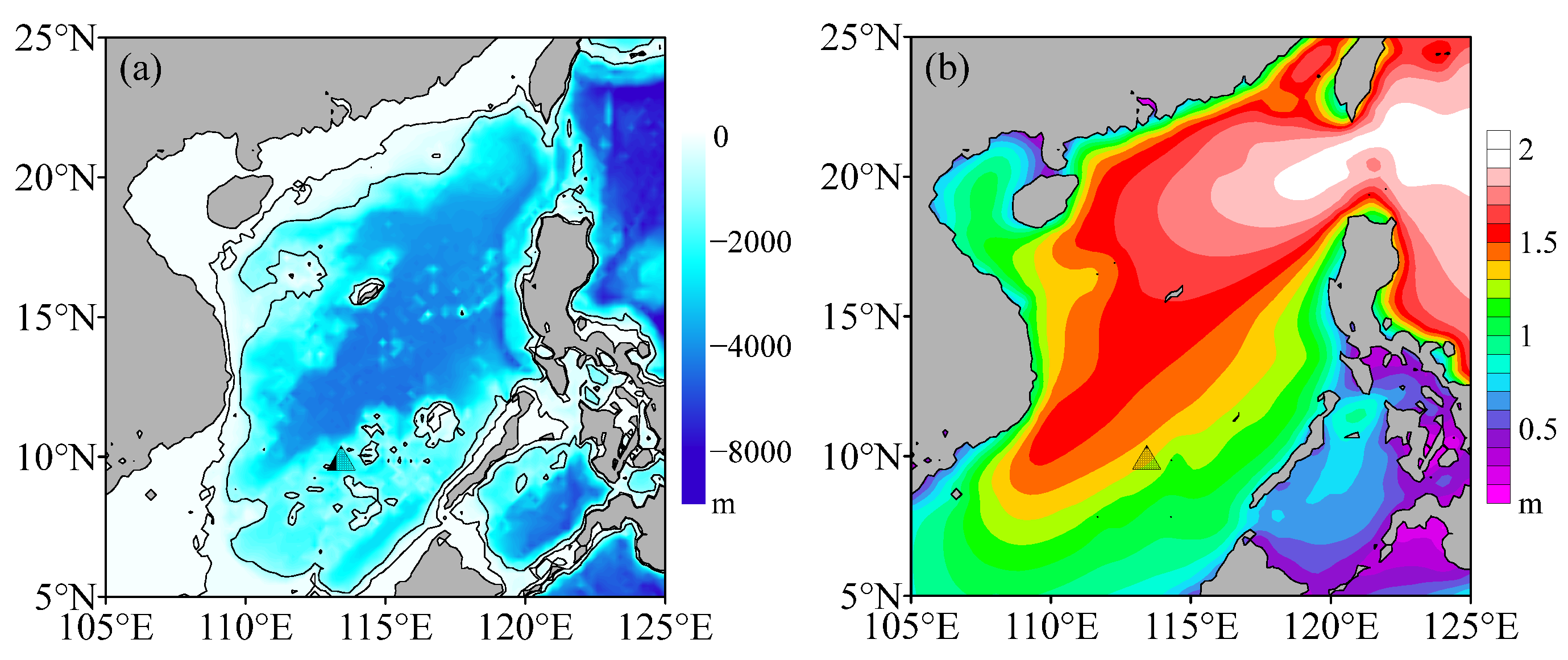
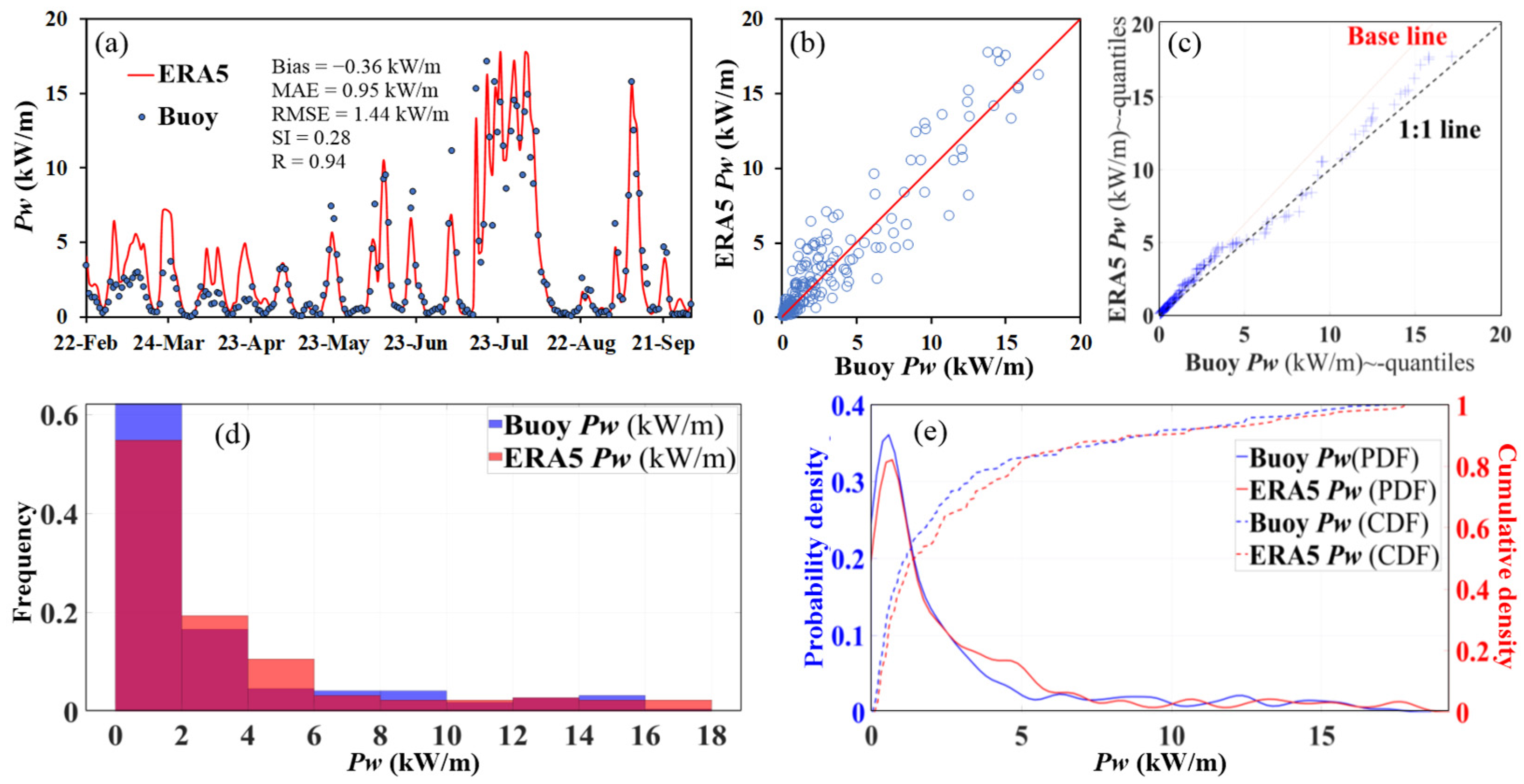
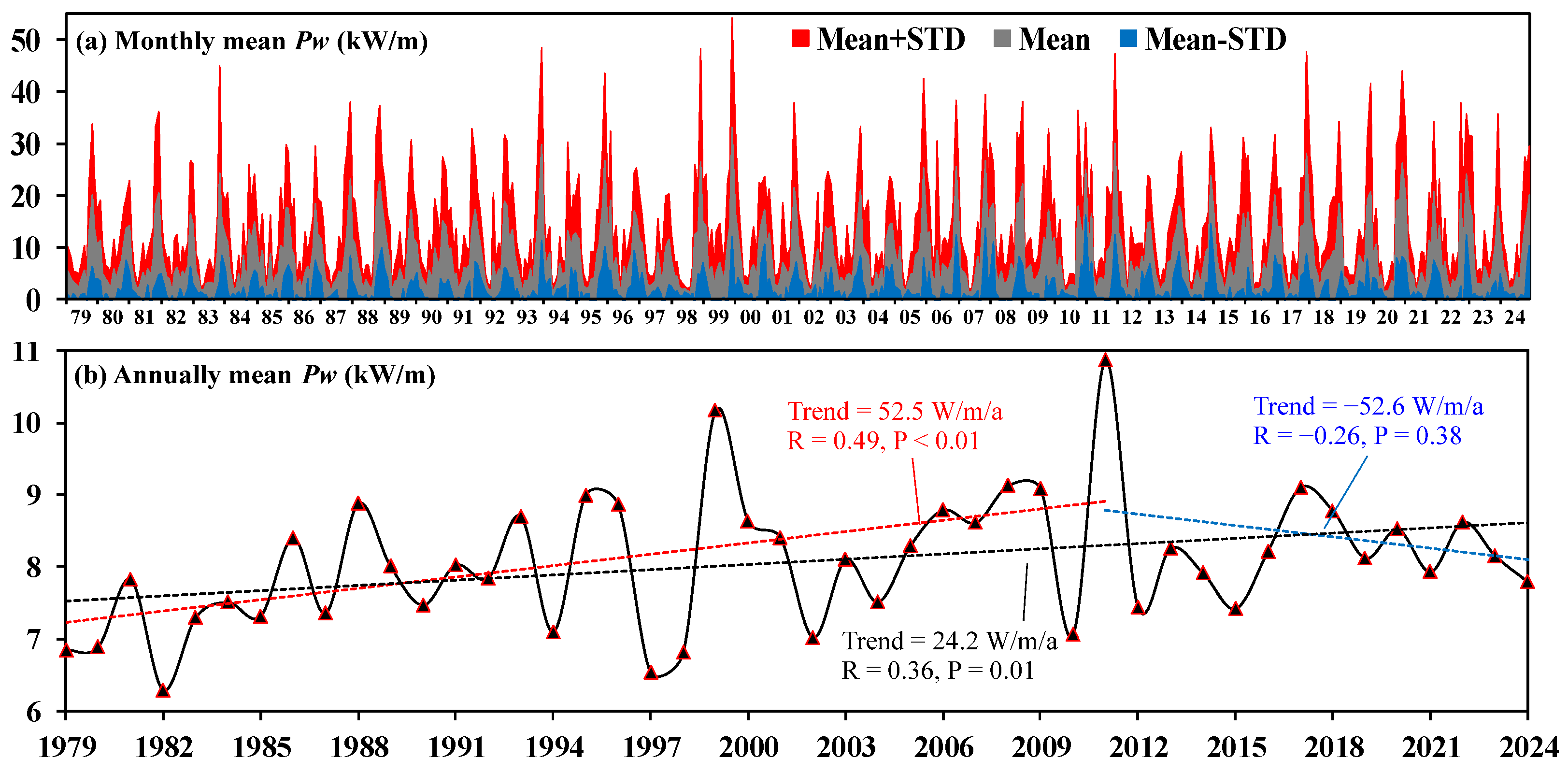

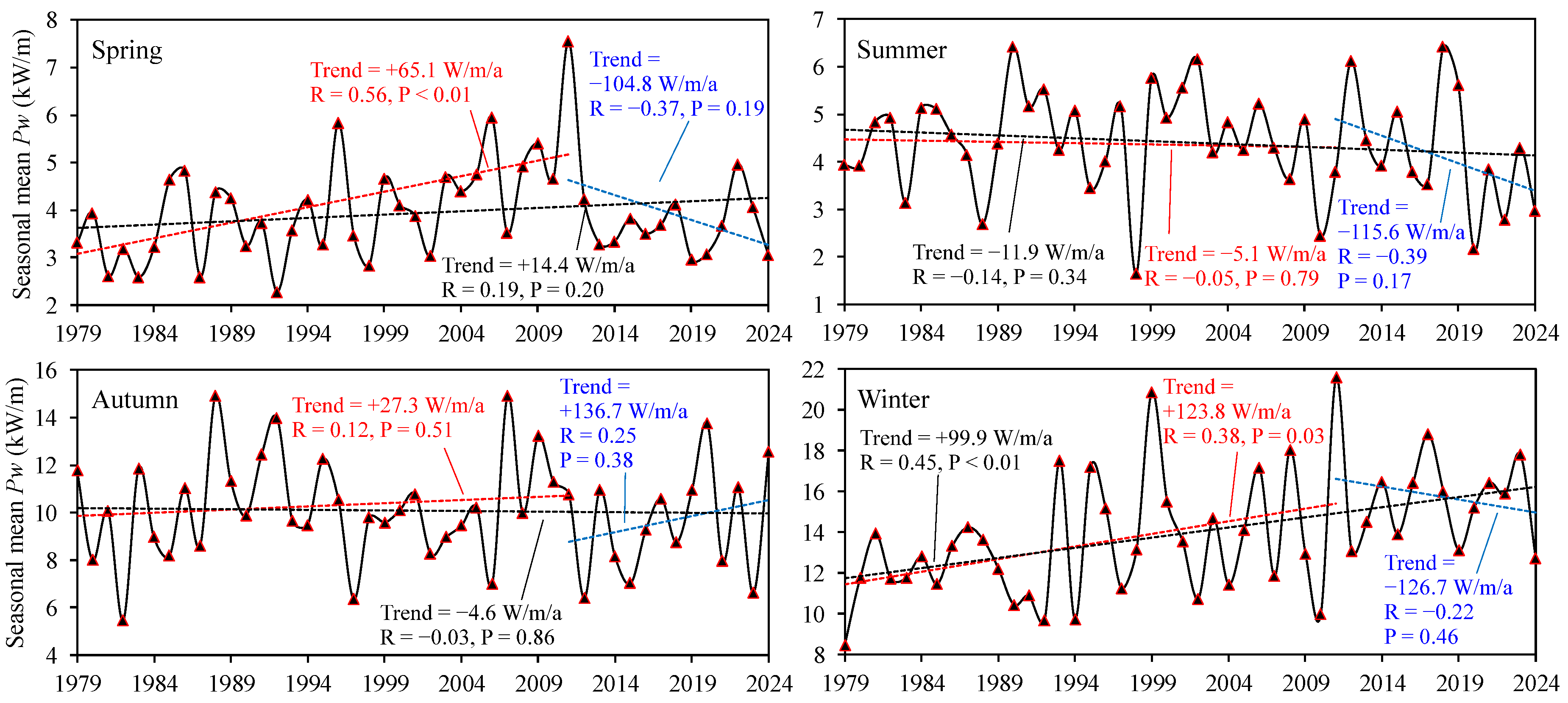
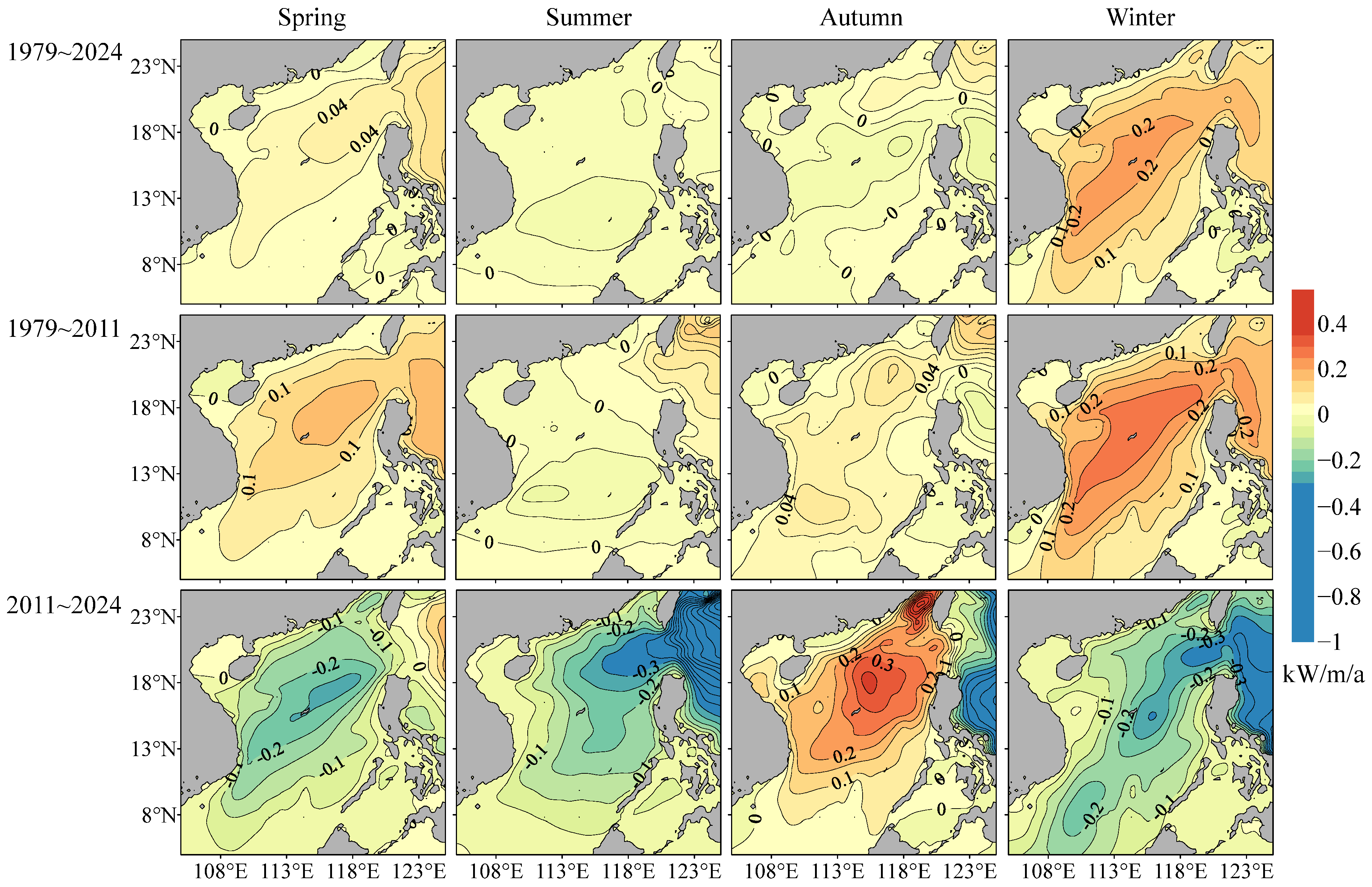
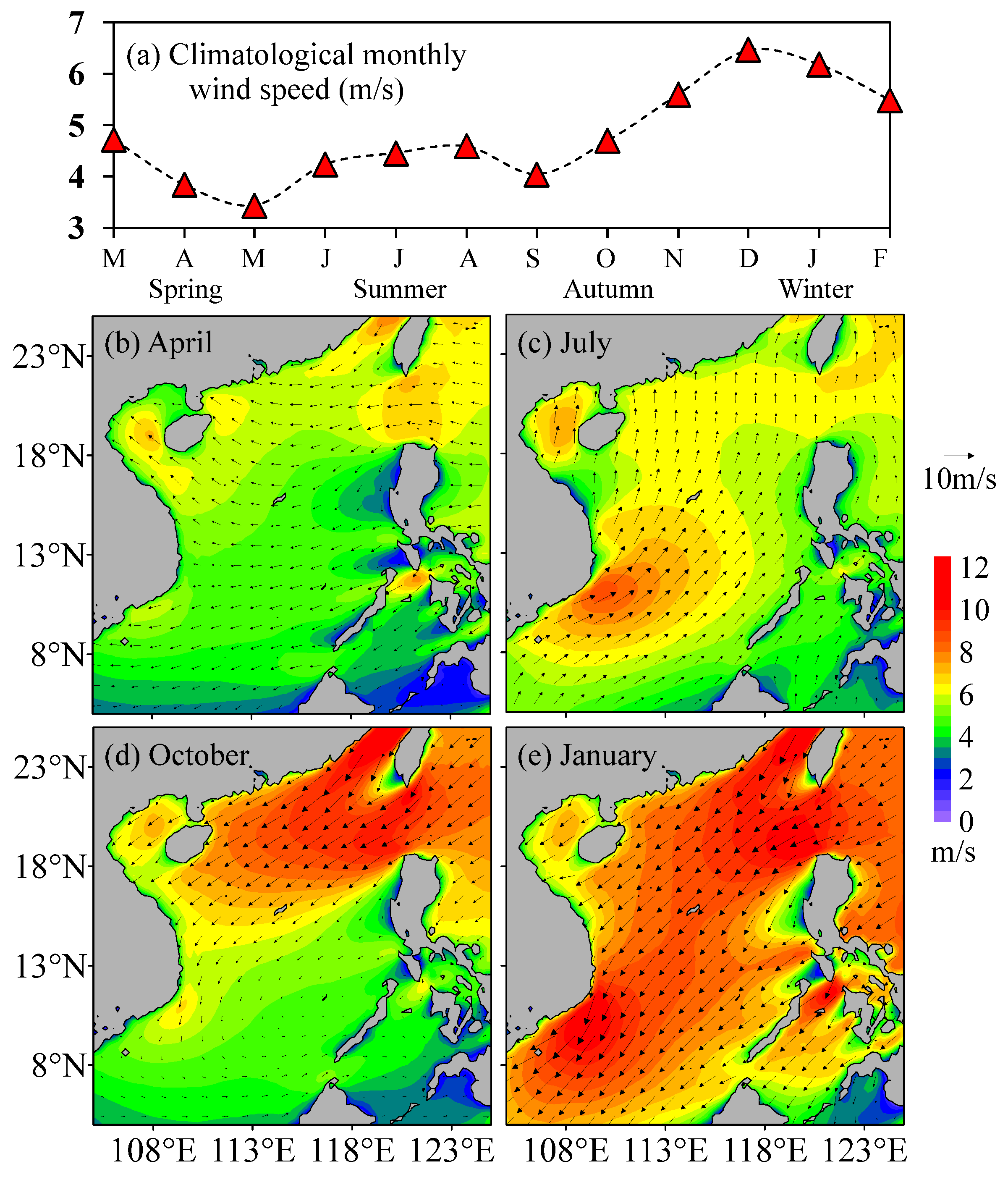
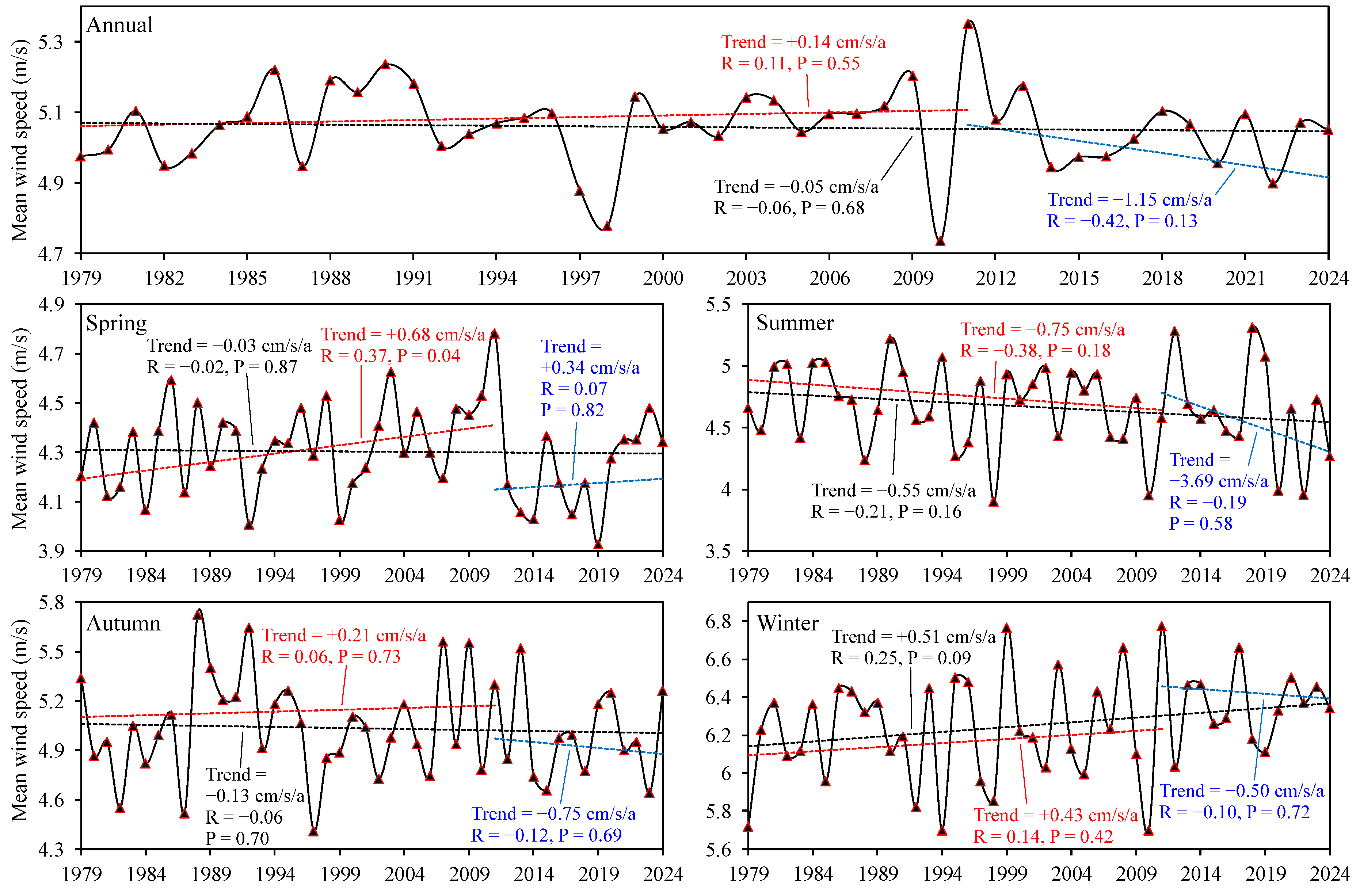

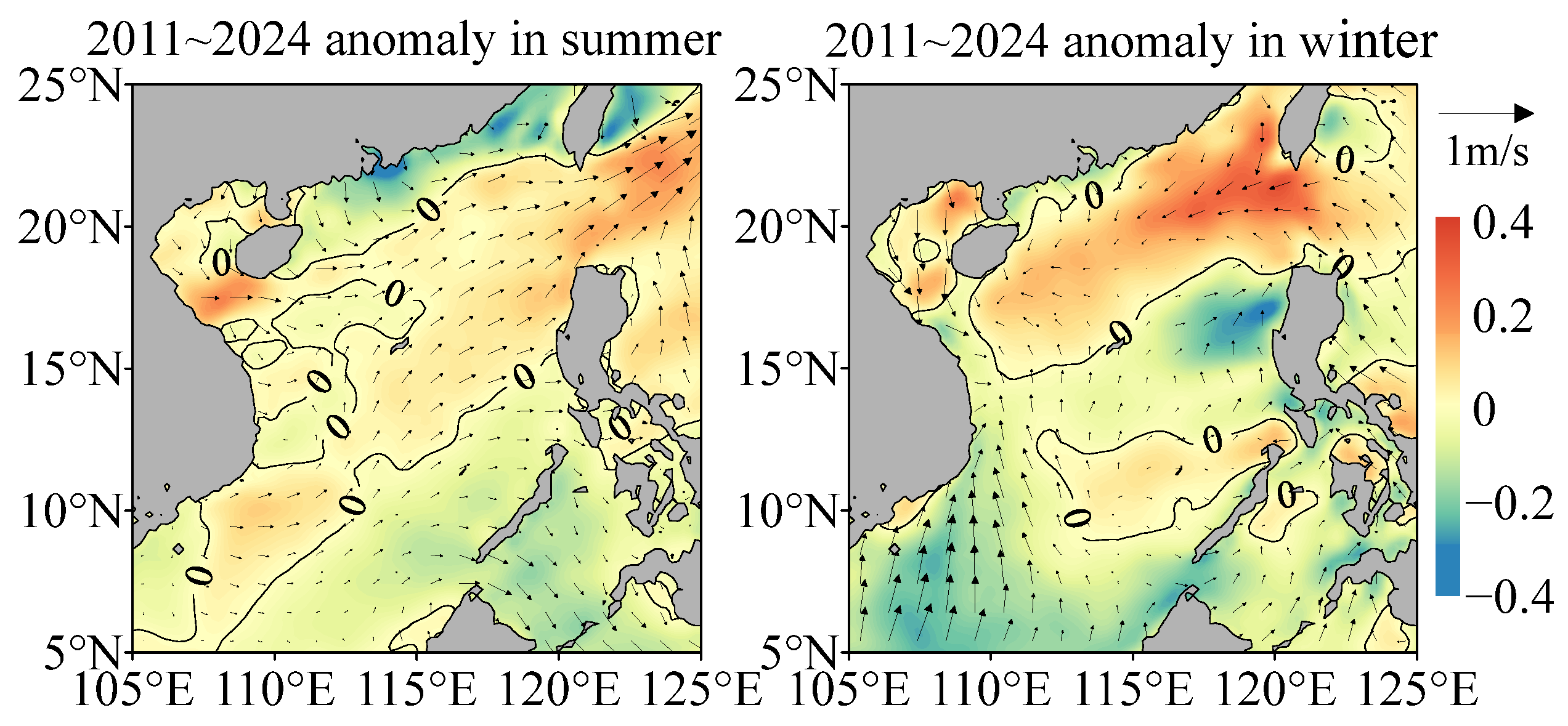
Disclaimer/Publisher’s Note: The statements, opinions and data contained in all publications are solely those of the individual author(s) and contributor(s) and not of MDPI and/or the editor(s). MDPI and/or the editor(s) disclaim responsibility for any injury to people or property resulting from any ideas, methods, instructions or products referred to in the content. |
© 2025 by the authors. Licensee MDPI, Basel, Switzerland. This article is an open access article distributed under the terms and conditions of the Creative Commons Attribution (CC BY) license (https://creativecommons.org/licenses/by/4.0/).
Share and Cite
Tong, Y.; Li, J.; Chen, W.; Li, B. Long-Term (1979–2024) Variation Trend in Wave Power in the South China Sea. J. Mar. Sci. Eng. 2025, 13, 524. https://doi.org/10.3390/jmse13030524
Tong Y, Li J, Chen W, Li B. Long-Term (1979–2024) Variation Trend in Wave Power in the South China Sea. Journal of Marine Science and Engineering. 2025; 13(3):524. https://doi.org/10.3390/jmse13030524
Chicago/Turabian StyleTong, Yifeng, Junmin Li, Wuyang Chen, and Bo Li. 2025. "Long-Term (1979–2024) Variation Trend in Wave Power in the South China Sea" Journal of Marine Science and Engineering 13, no. 3: 524. https://doi.org/10.3390/jmse13030524
APA StyleTong, Y., Li, J., Chen, W., & Li, B. (2025). Long-Term (1979–2024) Variation Trend in Wave Power in the South China Sea. Journal of Marine Science and Engineering, 13(3), 524. https://doi.org/10.3390/jmse13030524







